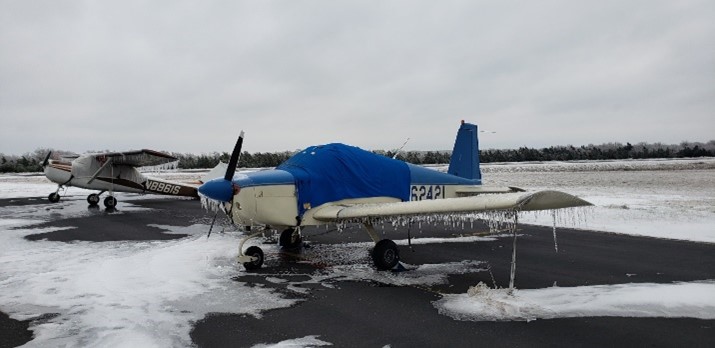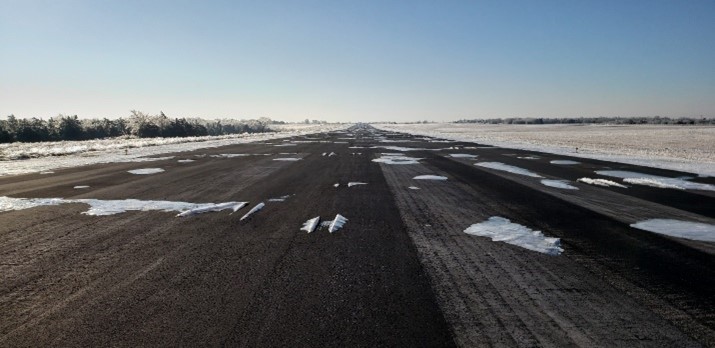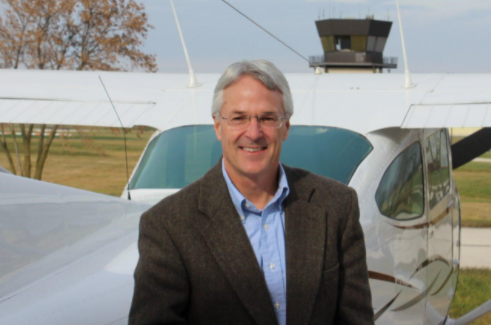We are from Wisconsin, and we live in the Milwaukee area. Our aircraft is a Cessna 182. My wife and I flew to College Station, TX on February 11, 2021. We landed at Coulter Field (KCFD) around 2:00 p.m. local time. It was cloudy and cold. Our plan was to spend a couple days in College Station for a campus visit with one of our daughters; then fly north to Amarillo for a few days (for another college campus visit), before flying home to Wisconsin.
Unfortunately, the forecast was for the first of the two bad winter storms to hit Texas over the February 13-14 weekend. So, we put the airplane in a hangar and drove our rental car to Amarillo. The storm that hit Texas over the weekend dropped record-breaking amounts of snow and ice across the state.
We got back to College Station on Tuesday, February 16. The plan was to fly home that afternoon, with good VFR weather in the forecast. When we got to the airport, we met the airport manager. He told us the airport was closed because there was snow and ice on the runway. I asked him when he expected to reopen the airport. He said: “When it melts.”

Most municipalities in central and southern Texas do not have any snow-removal equipment for their roads or their airports. They do not have snow plows or salt trucks. During the week of February 14-21, 2021, most general aviation airports from Dallas, to Longview, to Houston, to San Antonio, to Del Rio, to Abilene – and all areas in between (such as Austin, Waco and College Station) – were closed for at least a day or two. Some airports in that region were closed for several days. Similar situations developed in other states.
I have been flying for over 30 years – with lots of flying all over the U.S. during the winter months. This was the first time I had to deal with an airport closure due to snow/ice – where the airport would not be reopened until it melted.
Unfortunately, the forecast for the next few days in College Station included the second major winter storm and more record low temperatures – well below freezing. I thought to myself: “With more snow, ice, and cold air on the way; when will it melt for the airport to be reopened?”

Our immediate priority was finding a place to stay. This proved difficult due to the rolling blackouts and record cold temps. We called several hotels and were told they were closed because their water pipes had frozen, burst, and flooded their properties. Eventually, we found an Airbnb. It had not been cleaned, and it was cold and dark during the power outages. But, at least we had a place to sleep with running water.
We departed Texas on Friday afternoon, February 19th – after the temps finally got above freezing with some bright sunshine. To help get the airport opened, an employee went out on the runway in the morning with a dirt shovel (there were no snow shovels at the airport) to dig up and throw clumps of snow/ice from the center of the runway to the edges. We arrived back in Wisconsin Friday evening. It was cold, but it felt good to be home.
Our recent experience in Texas inspired me to write this article. Here is a question prompted by the TX trip: Does the FAA allow Part 91 pilots to make independent/personal determinations for safe use of restricted airspace, airports or runways when appropriate Notices to Airmen (NOTAMs) have been issued? The short answer is, generally, “No.”
According to the FAA, using airspace or an airport/runway closed pursuant to a NOTAM – even if 100% safe and successful – will usually trigger a violation of FAR 91.137(b), which forbids operating an aircraft within an area closed by a NOTAM. Such a flight will also expose the pilot to a violation of FAR 91.103, which requires pilots to be familiar with all available information before beginning a flight. In addition, such conduct could trigger a violation of FAR 91.13 as a careless/reckless act.
Here is an example. In FAA v. Somerville, 2004 NTSB LEXIS 12 (Mar. 26, 2004), the NTSB affirmed a 240-day suspension of the pilot’s private certificate for flying in the late morning on September 11, 2001. He went flying after the FAA issued its NOTAM grounding all civilian aircraft across the United States in response to the 9/11 hijackings and terrorist attacks. The FAA proved that the pilot: (1) failed to determine whether or not any NOTAMs had been issued before he took off, and (2) he flew in violation of a properly-issued NOTAM.
Part Two of this article will further discuss FAA rules and/or guidance for pilots dealing with runways and/or airports closed to due to bad weather.
The opinions expressed in this article are those of the author.
 Russ Klingaman is a partner at Hinshaw & Culbertson LLP. He also teaches Aviation Law at Marquette Law School, and is a past-President of the Lawyer Pilots Bar Association. His practice includes aviation law and intellectual property.
Russ Klingaman is a partner at Hinshaw & Culbertson LLP. He also teaches Aviation Law at Marquette Law School, and is a past-President of the Lawyer Pilots Bar Association. His practice includes aviation law and intellectual property.
As a pilot and aircraft owner, Russ has developed unique insights into aviation-related legal matters, including those involving the fast-changing legal landscape concerning unmanned aircraft systems (UAS or drones). Throughout his career, Russ has helped many clients deal with claims triggered by tragic/fatal aviation accidents. He also advises clients dealing with aviation-related transactions, regulatory compliance, and/or FAA enforcement actions.
Russ also assists businesses and individuals with protecting their intellectual property — including trade secrets, copyrights, trademarks, and patents. The IP transactional work encompasses projects such as licensing, assignments, or nondisclosure agreements. The IP litigation involves prosecuting or defending claims for misappropriation, infringement, breach of contract, unfair competition, etc.
Russ focuses on effectively leverage opportunities, resolve disputes, and reduce risks; while finding practical and effective solutions to clients’ legal challenges. He has handled a wide variety of high-profile cases involving multi-million dollar claims for personal injuries, property damage, and/or business losses. He has also handled numerous appeals and has made oral arguments to the U.S. Courts of Appeals for the Seventh and Ninth Circuits, and the Wisconsin Supreme Court.





 Russ Klingaman is a partner at Hinshaw & Culbertson LLP. He also teaches Aviation Law at Marquette Law School, and is a past-President of the Lawyer Pilots Bar Association. His practice includes aviation law and intellectual property.
Russ Klingaman is a partner at Hinshaw & Culbertson LLP. He also teaches Aviation Law at Marquette Law School, and is a past-President of the Lawyer Pilots Bar Association. His practice includes aviation law and intellectual property.

